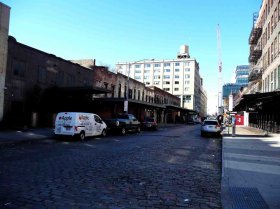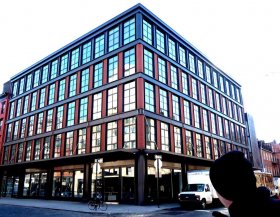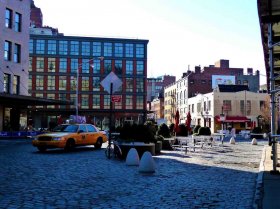Meat packing industry today
Location
Based upon the edge of Manhattan, sitting southwards of Chelsea, it consists of 20-square blocks. It's location has become a culture hub for many purposes, varying from fashion to food.
Image sourced by Google Earth
The District
The district itself is of medium density and has been controlled strongly away from developers creating high rise buildings within the area. The district has had an important focus on containing the heritage and 'feel' of the area, through developing in a controlled manner that has a minimal impact on the existing industrial environment. The Meat Packing District today has a powerful link to its history and has always been considered as a priority. Whilst the use of the site has changed dramatically, elements of the past are still integrated into new designs.
The Meat Packing District today has a powerful link to its history and has always been considered as a priority. Whilst the use of the site has changed dramatically, elements of the past are still integrated into new designs.
History
The district was originally based for residential living during the early 1800's, although the introduction of markets began in the 1840's. It wasn't until the late 1800's however the meat packing industry began to boom. In 1884 2 acres of land was designated for new markets. The district was named The Gansevoort Market from when the street was a Fort controlled by one of George Washington’s officers, General Peter Gansevoort in the early 1800's.This altered the shift of the neighbourhood to become a market district. Unlike most neighbourhoods where residential buildings were torn down when commercial buildings were needed, most were retained and converted into commercial warehouses. The markets began focusing on fresh produce but after the development of refrigeration; meat became the primary product. By 1900 the district was thriving with more than 250 slaughterhouses and packing plants. The industry continued to thrive in to the 1930's; becoming the nation's third largest meat distribution centre. In the 1934 the Highline railway was completed, thus allowing easier distribution.
The district was named The Gansevoort Market from when the street was a Fort controlled by one of George Washington’s officers, General Peter Gansevoort in the early 1800's.This altered the shift of the neighbourhood to become a market district. Unlike most neighbourhoods where residential buildings were torn down when commercial buildings were needed, most were retained and converted into commercial warehouses. The markets began focusing on fresh produce but after the development of refrigeration; meat became the primary product. By 1900 the district was thriving with more than 250 slaughterhouses and packing plants. The industry continued to thrive in to the 1930's; becoming the nation's third largest meat distribution centre. In the 1934 the Highline railway was completed, thus allowing easier distribution.


